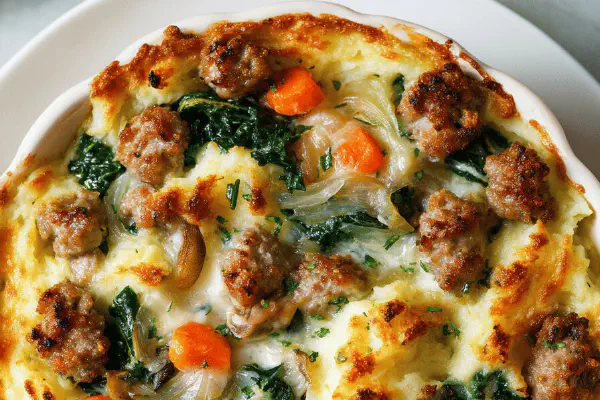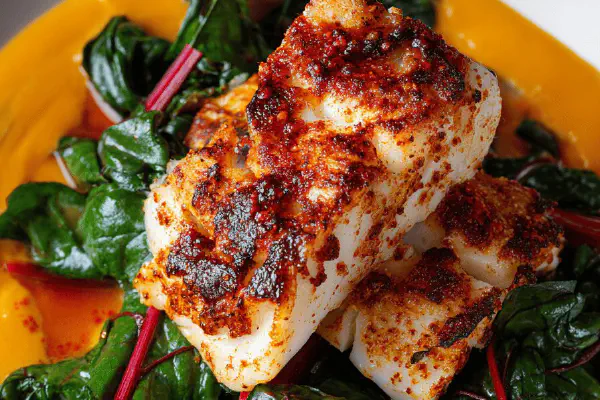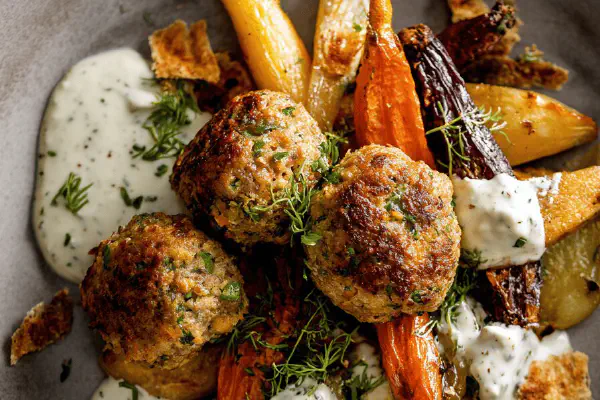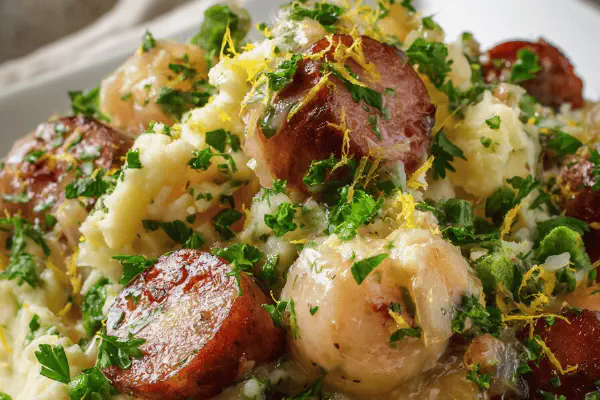Rustic Sausage Shepherds Pie

By Emma
Certified Culinary Professional
Ingredients
Mashed Potato Layer
- 900 ml peeled cubed Yukon Gold potatoes (about 4 cups)
- 75 ml butter (5 tablespoons)
- 125 ml whole milk
- 1 egg lightly beaten
- 200 g grated parmesan cheese
- Salt and freshly ground black pepper
Filling
- 700 g mild Italian pork sausages (about 5 links, casings removed)
- 30 ml olive oil
- 2 medium fennel bulbs finely chopped
- 227 g button mushrooms quartered
- 500 ml finely shredded kale, tightly packed
- 2 garlic cloves minced
- 250 ml dry white wine or chicken broth
- 250 ml diced fresh carrots
- Salt and freshly ground black pepper
About the ingredients
Method
Mashed Potato Layer
- 1. Drop potato cubes in large pot of boiling salted water. Cook until fork-tender but not falling apart—test after 15-20 min. Drain thoroughly. Return hot potatoes to pot off heat. Stir in butter; let melt slowly in residual heat—no over-stirring to avoid gluey mash.
- 2. Warm milk separately to lukewarm. Add gradually while mashing with hand masher or ricer for fluffy texture. Stir in beaten egg for binding and shine; season with salt and pepper. Fold in half the parmesan. Cover to keep warm until assembly.
Filling
- 3. Heat olive oil in heavy pan over medium heat. Break sausage into chunks, sauté until browned but not fully cooked through—about 7 minutes. Remove sausage, set aside.
- 4. Using same pan, cook fennel until softened and golden edges appear, around 8 minutes. Adds sweet, anise aroma that cuts richness. Toss in mushrooms and sauté until juices evaporate and edges crisp, another 5-7 min. Salt now to draw moisture out.
- 5. Add kale and garlic; cook until kale wilts but retains some texture, about 3 minutes. Pour in wine or broth to deglaze—scrape browned bits for deep flavor. Simmer until liquid reduces slightly, about 5 minutes. Add diced carrots, cook gently so still crunchy, not mushy. Return sausage to pan; mix thoroughly. Adjust seasoning.
Assembly
- 6. Preheat oven 175°C (350°F). Lightly oil 28x20 cm baking dish. Spread sausage-vegetable mixture evenly on bottom. Press down to compact layers; prevents soggy bottom.
- 7. Dollop mashed potatoes over filling; spread evenly with offset spatula. Sprinkle remaining parmesan thickly.
- 8. Place dish on center rack. Bake for 40-50 minutes. Watch for bubbling edges and golden cheese crust; flaky spots indicate doneness.
- 9. Let rest 10 minutes before cutting—locks layers, easier serving.
Notes
- - Potatoes must be well drained to avoid watery mash.
- - Use sharp knife to dice fennel for even cooking.
- - Egg in mash speeds browning and holds texture after baking.
- - White wine optional but adds acid brightness; broth works if none.
- - Kale swaps for cabbage, holding firmer after baking than traditional varieties. Offers bitter counterpoint.
- - Carrots instead of peas give subtle sweetness and crunch contrast.
- - Avoid overcooking filling or mash to prevent dry result.
- - If sausages too fatty, spoon off excess during cooking.
- - Resting key—serves well leftover too.
Cooking tips
Chef's notes
- 💡 Potatoes drained well keeps mash firm; watery mash means sloppy top layer. Use Yukon Gold for creaminess, avoid Russets or waxy spuds disintegrate fast. Butter melts off heat, slow; avoid stirring too much or you get glue instead of fluff. Milk warmed lukewarm; cold kills softness. Add egg last to hold mash amid oven heat—binds and browns nicely, skip egg for fluff but fragile top.
- 💡 Browning sausage chunks till edges crisp, not cooked through; carry on cooking layered. Fat renders slowly, flavors build bottom. Fennel softens slowly in olive oil, edges turning golden. Adds subtle anise scent, cuts richness from pork. Mushrooms sweat first, then fry dry edges crisp; wet mushrooms stew and lose texture. Salt mushrooms after juices start releasing or you lock moisture in.
- 💡 Add kale at last before deglaze; wilts without turning mushy. Garlic near end, sharp smell can burn fast. Deglaze with wine or broth, scrape brown bits stuck on pan bottom, that's umami depth. Reduce liquid enough but keep some moisture. Carrots diced fresh, added last to keep crunch; peas swap works if carrots missing but less texture contrast.
- 💡 Layer tight, compact with spatula or fingers pressing down to stop juices leaking out during baking. Too loose layers means watery bottom or soggy crust. Cheese spread thick on top; melts, browns and seals mash from drying. Oven mid-rack, 175°C steady heat. Watch bubbling edges and golden cheese spots. Rest 10 minutes after baking; warmth settles layers, makes slicing cleaner.
- 💡 If sausages fatty, spoon fat off during cooking or bake too greasy. Swap fennel for sweet onion plus pinch fennel seeds if no bulbs available. Butter can trade for olive oil but less stable heat wise. Parmesan sharp nutty flavor key; aged cheddar alternative but milder. Mushrooms brown button preferred; shiitake adds earthiness, swap as needed. White wine optional; broth or water fallback but less brightness.
Common questions
How to avoid gluey mash?
Drain potatoes super well or mix sticks. Use warm milk. Butter melts slow off heat. Add beaten egg last. Don't mash too much or stirring overdone—fluffy texture comes from just right mashing and timing. Tried skipping egg once, mash crumbly top, next time added, crisp top formed better.
Can I replace kale?
Yes, cabbage works but soggier after baking. Kale holds texture better, faint bitterness adds balance. If no kale, spinach can wilt too fast, mush. Fennel can swap for sweet onion plus fennel seeds for aroma similar. Mushrooms can be button or shiitake depending on depth wanted. Carrots best for crunch, peas softer alternative.
What if filling too wet?
Drain sausage fat mid-cook. Mushrooms dry fry edges before adding kale. Salt mushrooms after sweating draws out moisture. Avoid overcooking mash so excess moisture doesn’t run down. Bake time key toaster for evaporation. If watery, next time press layers tighter. Let pie rest before cutting to firm layers better.
How to store leftovers?
Cool completely then fridge 2-3 days best. Reheat oven covered to keep moist, air fryer crisp top. Can freeze in airtight container; thaw 24 hrs fridge prior to baking reheating. Leftover slices heat up well skillet on medium low. Avoid microwave if possible keeps textures intact. Rest again before serving leftovers.



